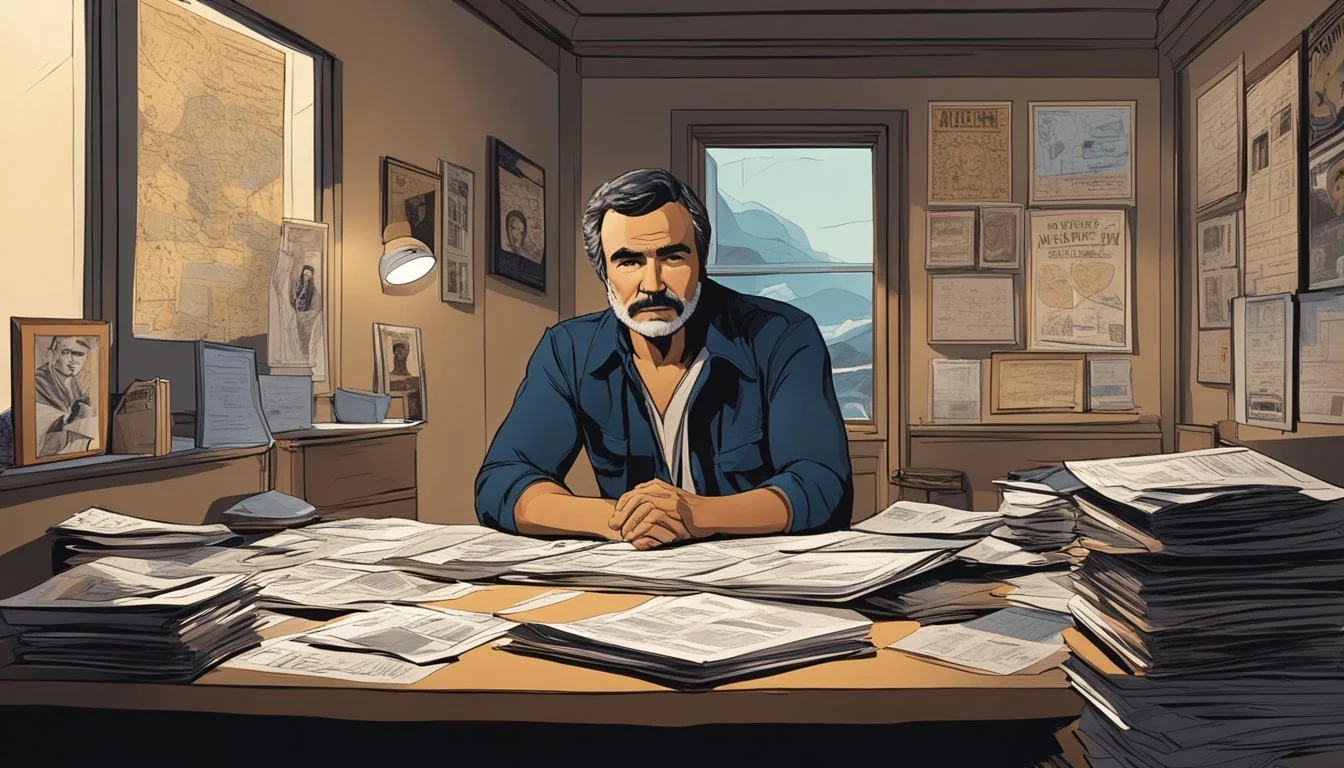Hollywood Heartthrob's Heartache: Burt Reynolds' Battle with Depression
Behind the Smile of a Screen Icon
Burt Reynolds, the iconic Hollywood heartthrob of the 1970s and 1980s, captivated audiences with his charismatic charm and rugged good looks. Known for his roles in films like "Smokey and the Bandit" and "Deliverance," Reynolds became one of the biggest box office stars of his era. Behind the scenes, however, the actor grappled with a silent struggle against depression that would shape his later years.
Reynolds' battle with mental health issues was compounded by physical pain from movie stunt injuries and financial troubles. The once-celebrated star found himself facing a harsh reality as his career waned and health declined. His journey from top billing to financial hardship and health challenges offers a poignant look at the pressures of fame and the toll it can take on even the most seemingly invincible stars.
The Rise of Burt Reynolds
Burt Reynolds' ascent to stardom was marked by his rugged charm and undeniable screen presence. His journey from a small-town boy to Hollywood icon captivated audiences worldwide.
Early Career and Breakthrough
Reynolds began his acting career in the late 1950s with small television roles. He gained attention as Quint Asper on "Gunsmoke" from 1962 to 1965. His film debut came in 1961's "Angel Baby," but it was "Deliverance" in 1972 that truly launched him to stardom.
The critically acclaimed thriller showcased Reynolds' acting prowess and cemented his status as a leading man. His rugged good looks and charismatic performance caught the eye of both critics and audiences.
Becoming a Box Office Sensation
Reynolds' career skyrocketed in the mid-1970s. He became synonymous with high-octane action comedies like "Smokey and the Bandit" (1977). The film was a massive hit, solidifying his status as a box office draw.
His charm and comedic timing shone in "The Best Little Whorehouse in Texas" (1982). Reynolds dominated the box office for nearly a decade, becoming one of Hollywood's most bankable stars.
His appeal extended beyond action roles. "Boogie Nights" (1997) showcased his dramatic range, earning him an Oscar nomination. Reynolds' versatility and charisma made him a true Hollywood heartthrob and a beloved figure in American cinema.
Personal Struggles Behind the Spotlight
Burt Reynolds faced numerous personal challenges throughout his life and career. His struggles with relationships, health issues, and substance abuse took a toll on his mental well-being and public image.
Intimate Relations and Public Scrutiny
Reynolds' high-profile relationships often made headlines. His marriages to Loni Anderson and Judy Carne ended in divorce, while his romance with Sally Field became a subject of public fascination. The actor also dated Dinah Shore, who was 20 years his senior.
These relationships were frequently scrutinized by the media, putting additional pressure on Reynolds. The constant attention and speculation about his personal life contributed to his anxiety and depression.
Health Battles and Seeking Treatment
Reynolds' physical health problems compounded his mental health struggles. He underwent back surgery in the 1980s, which led to a dependency on painkillers. The actor battled addiction and eventually sought treatment in rehab.
In 2009, Reynolds had quintuple bypass surgery after experiencing chest pain. He later suffered a heart attack in 2010. These health scares forced him to confront his mortality and reassess his lifestyle.
Reynolds also struggled with the sleep medication Halcion, which he claimed caused erratic behavior. In 1992, he entered a treatment center to address his substance abuse issues. The actor's journey to recovery was challenging but ultimately helped him regain control of his life.
Professional Highs and Lows
Burt Reynolds experienced a rollercoaster career in Hollywood, marked by both tremendous successes and notable setbacks. His journey through the entertainment industry showcased his versatility as an actor and his resilience in the face of challenges.
Acclaimed Performances and Critical Acclaim
Reynolds gained widespread recognition for his roles in Western films, establishing himself as a charismatic leading man. His performance in "Deliverance" (1972) showcased his dramatic range and earned him critical praise. In 1977, Reynolds starred in "Smokey and the Bandit," which became a massive box office hit and cemented his status as a Hollywood icon.
The actor's talent shone in "Terms of Endearment" (1983), where he played a supporting role alongside Shirley MacLaine and Jack Nicholson. This performance demonstrated his ability to hold his own against established stars.
Reynolds' career reached new heights with "Boogie Nights" (1997). His portrayal of adult film director Jack Horner earned him an Academy Award nomination for Best Supporting Actor, showcasing his enduring talent and ability to reinvent himself.
Setbacks and Recovery
Despite his successes, Reynolds faced significant career setbacks. His 1984 film "City Heat," co-starring Clint Eastwood, underperformed at the box office and was met with lukewarm reviews. This disappointment was compounded by personal health issues that affected his ability to work.
The late 1980s and early 1990s saw Reynolds struggle with a string of less successful films. He also faced financial difficulties, declaring bankruptcy in 1996. These challenges tested his resilience and public image.
Reynolds' appearance in Cosmopolitan Magazine's nude centerfold in 1972 initially boosted his popularity but later became a source of regret. He believed it overshadowed his acting abilities and affected how he was perceived in the industry.
Despite these setbacks, Reynolds staged a comeback. His role in "Boogie Nights" revitalized his career, proving his ability to adapt and excel in diverse roles. This resurgence demonstrated his enduring appeal and talent, solidifying his place among Hollywood's most memorable stars.
Legacy and Influence
Burt Reynolds left an indelible mark on American cinema and popular culture. His charismatic presence and memorable performances continue to influence actors and filmmakers today.
Contribution to American Cinema
Reynolds redefined the image of the Hollywood leading man in the 1970s and 1980s. His rugged charm and effortless cool in films like "Deliverance" and "Smokey and the Bandit" captivated audiences nationwide.
As a box office powerhouse, Reynolds ranked among Hollywood's top 10 moneymakers for over a decade. He held the number one spot from 1978 to 1982, a testament to his widespread appeal and bankability.
Reynolds' versatility as an actor shone through in both comedic and dramatic roles. His portrayal of Jack Horner in "Boogie Nights" (1997) earned him critical acclaim and an Oscar nomination, showcasing his range late in his career.
Tributes and Remembrances
Following his passing in 2018, tributes poured in from fellow actors, directors, and fans. Many praised Reynolds' generosity, professionalism, and lasting impact on the film industry.
The Hollywood Museum honored Reynolds with a special auction, featuring memorabilia from his iconic roles. This event celebrated his contributions to Western films and TV shows like "Gunsmoke."
Reynolds' legacy lives on through film retrospectives, documentaries, and the countless actors he inspired. His journey from Hollywood heartthrob to respected character actor serves as a blueprint for longevity in the entertainment industry.





